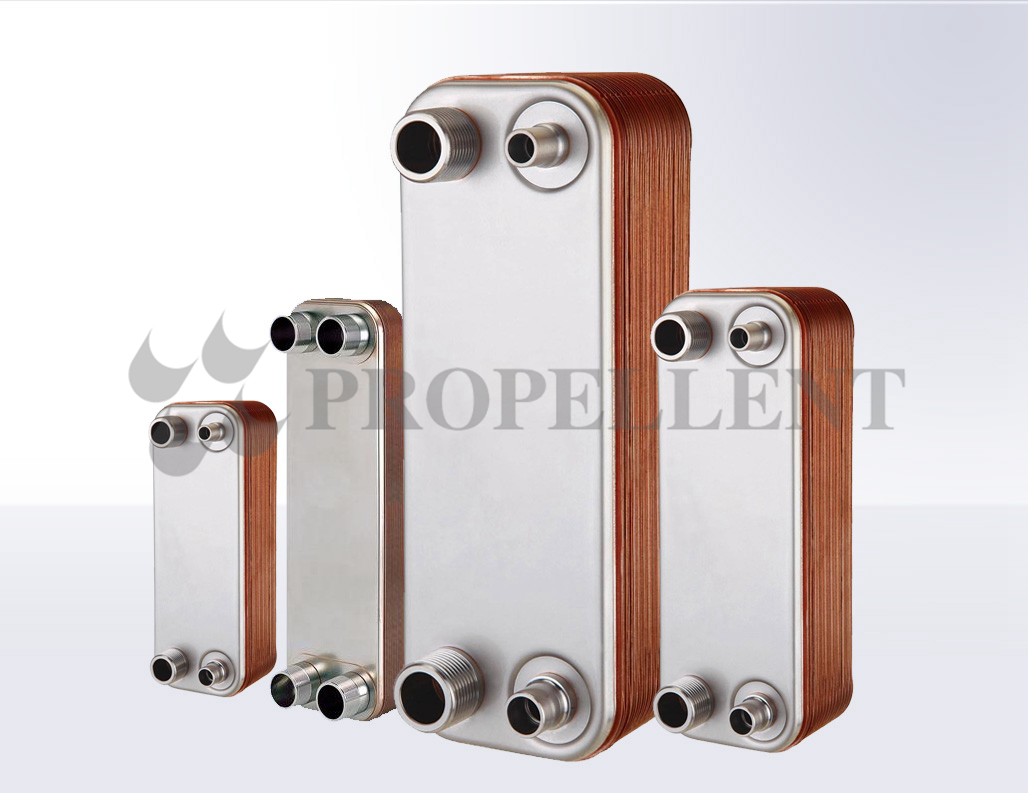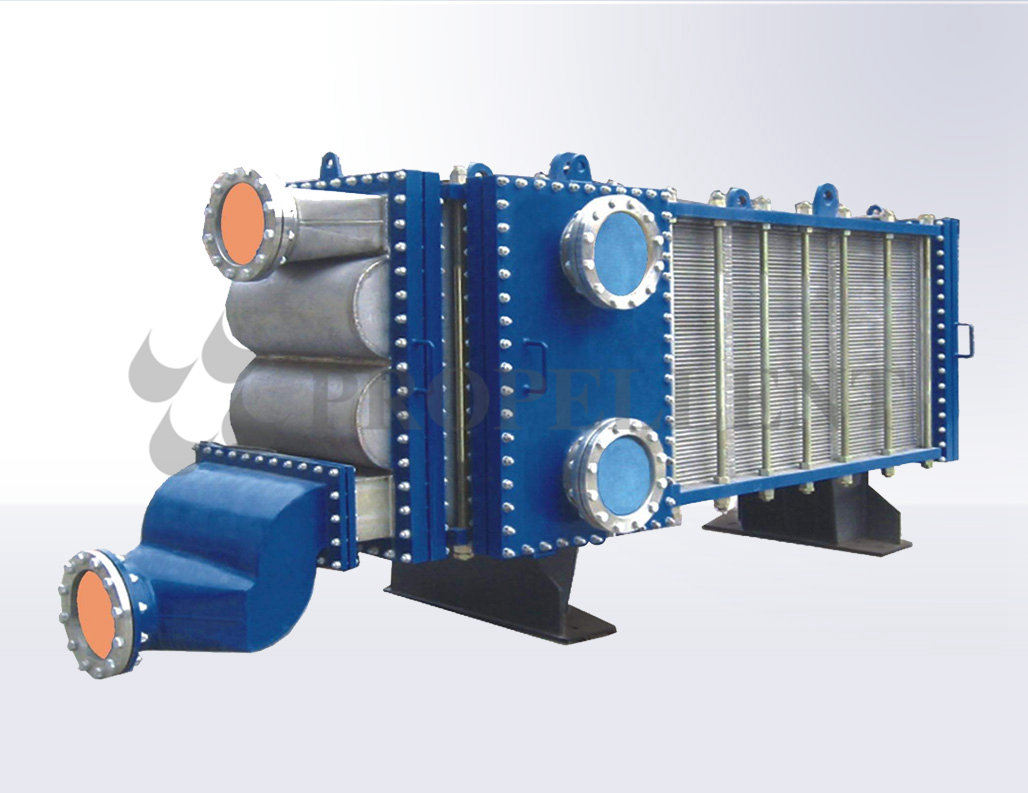Position: Home>News Center>Industry news>What are the differences and advantages between "plate heat exchanger" and shell and tube heat exchanger?
Industry news
What are the differences and advantages between "plate heat exchanger" and shell and tube heat exchanger?
Source
:http://www.puruipule.cn
Time:2020-05-09 11:02:18
Clicks:490
The differences and advantages of plate heat exchangers and shell and tube heat exchangers are mainly from the following points:
1. High heat transfer coefficient
The plate heat exchanger is composed of different plates inverting each other to form a complex flow channel, which causes the fluid to generate turbulence under the lower Reynolds number (generally Re = 50 ~ 200) in the flow channel, so the heat transfer coefficient is high, which is generally 3 ~ 5 times of shell type.
2. Small footprint
The plate heat exchanger has a compact structure. The heat exchange area per unit volume is 2 to 5 times that of the tube and shell type. The same heat exchange amount is achieved. The plate area is about 1/5 to 1/8 of the tube and shell type. For the overhaul, it is necessary to draw out the inspection place of the tube bundle, while for the plate type, it is only necessary to leave the position for removing the plate.
3. Light weight
The plate thickness of the plate heat exchanger is generally 0.4 ~ 0.8mm, and the thickness of the shell and tube heat exchange tube is 2.0 ~ 2.5mm. The shell and tube shell is also much heavier than the plate frame. Therefore, the plate heat exchanger The weight of the device is generally only about 1/5 of the tube and shell type.
4. The logarithmic average temperature difference is large, and the terminal temperature difference is small
Plate heat exchangers are mostly co-current or counter-current flow, the logarithmic average temperature difference correction coefficient is about 0.95. The two fluids of the tube and shell heat exchanger flow respectively in the tube side and the shell side, which are generally cross-flow and the logarithmic average temperature difference is small; in addition, the flow of cold and hot fluids in the plate heat exchanger is parallel On the heat exchange surface, there is no side flow, so the temperature difference at the end of the plate heat exchanger is small, and the heat exchange to water can be less than 1 ℃, while the shell and tube type is generally 5 ℃.
5. Easy to change heat exchange area or process combination
If you want to increase or decrease the heat exchange area, you only need to increase or decrease the plates; if you want to change the process combination, you only need to change the plate arrangement or replace a few plates to adapt to the new heat exchange conditions; The thermal area is almost impossible to increase.
6. Convenient processing and production
Plate heat exchanger plates are stamped in batches, with a high degree of standardization and mass production. Tube and shell heat exchangers are generally made by hand.
7. Lower price
Under the same material and the same heat exchange area, the price of the plate heat exchanger is about 40% to 60% lower than that of the shell and tube type.
8. Not easy to scale
Due to the turbulent flow of fluid in the flow path between the plates, it is not easy to foul, and its fouling coefficient is only 1/3 ~ 1/10 of the shell and tube heat exchanger.
9. Easy to disassemble and clean
As long as the plate heat exchanger loosens the clamping bolt and moves the movable end plate, the plate can be removed for cleaning, which is very suitable for the working conditions that require frequent cleaning and maintenance.
10. Large pressure loss per unit length
Because the gap between the heat transfer surfaces is small and there are irregularities on the heat transfer surface, the pressure loss is greater than that of the conventional smooth tube.
11. Working pressure and temperature should not be too large
The plate heat exchanger is sealed with a sealing gasket, and the working pressure should generally not exceed 2.5MPa. The medium temperature should be below the bearing range of the gasket, otherwise the heat exchanger will leak.
12. Easy to block
The channels between the plates are narrow, generally only 2 ~ 5mm. When the heat exchange medium contains large particles or fibrous materials, it is easy to block the channels between the plates. In this case, a wide-flow plate heat exchanger can be used, which has good passability and avoids clogging.
1. High heat transfer coefficient
The plate heat exchanger is composed of different plates inverting each other to form a complex flow channel, which causes the fluid to generate turbulence under the lower Reynolds number (generally Re = 50 ~ 200) in the flow channel, so the heat transfer coefficient is high, which is generally 3 ~ 5 times of shell type.
2. Small footprint
The plate heat exchanger has a compact structure. The heat exchange area per unit volume is 2 to 5 times that of the tube and shell type. The same heat exchange amount is achieved. The plate area is about 1/5 to 1/8 of the tube and shell type. For the overhaul, it is necessary to draw out the inspection place of the tube bundle, while for the plate type, it is only necessary to leave the position for removing the plate.
3. Light weight
The plate thickness of the plate heat exchanger is generally 0.4 ~ 0.8mm, and the thickness of the shell and tube heat exchange tube is 2.0 ~ 2.5mm. The shell and tube shell is also much heavier than the plate frame. Therefore, the plate heat exchanger The weight of the device is generally only about 1/5 of the tube and shell type.
4. The logarithmic average temperature difference is large, and the terminal temperature difference is small
Plate heat exchangers are mostly co-current or counter-current flow, the logarithmic average temperature difference correction coefficient is about 0.95. The two fluids of the tube and shell heat exchanger flow respectively in the tube side and the shell side, which are generally cross-flow and the logarithmic average temperature difference is small; in addition, the flow of cold and hot fluids in the plate heat exchanger is parallel On the heat exchange surface, there is no side flow, so the temperature difference at the end of the plate heat exchanger is small, and the heat exchange to water can be less than 1 ℃, while the shell and tube type is generally 5 ℃.
5. Easy to change heat exchange area or process combination
If you want to increase or decrease the heat exchange area, you only need to increase or decrease the plates; if you want to change the process combination, you only need to change the plate arrangement or replace a few plates to adapt to the new heat exchange conditions; The thermal area is almost impossible to increase.
6. Convenient processing and production
Plate heat exchanger plates are stamped in batches, with a high degree of standardization and mass production. Tube and shell heat exchangers are generally made by hand.
7. Lower price
Under the same material and the same heat exchange area, the price of the plate heat exchanger is about 40% to 60% lower than that of the shell and tube type.
8. Not easy to scale
Due to the turbulent flow of fluid in the flow path between the plates, it is not easy to foul, and its fouling coefficient is only 1/3 ~ 1/10 of the shell and tube heat exchanger.
9. Easy to disassemble and clean
As long as the plate heat exchanger loosens the clamping bolt and moves the movable end plate, the plate can be removed for cleaning, which is very suitable for the working conditions that require frequent cleaning and maintenance.
10. Large pressure loss per unit length
Because the gap between the heat transfer surfaces is small and there are irregularities on the heat transfer surface, the pressure loss is greater than that of the conventional smooth tube.
11. Working pressure and temperature should not be too large
The plate heat exchanger is sealed with a sealing gasket, and the working pressure should generally not exceed 2.5MPa. The medium temperature should be below the bearing range of the gasket, otherwise the heat exchanger will leak.
12. Easy to block
The channels between the plates are narrow, generally only 2 ~ 5mm. When the heat exchange medium contains large particles or fibrous materials, it is easy to block the channels between the plates. In this case, a wide-flow plate heat exchanger can be used, which has good passability and avoids clogging.
Keywords:plate heat exchanger



